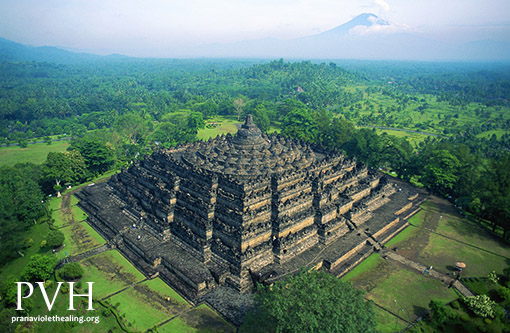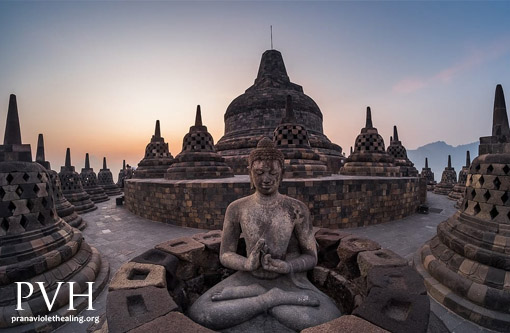
Borobudur is a 9th-century Mahayana Buddhist Monument in Magelang, Central Java, Indonesia. The monument consists of six square platforms topped by three circular platforms and is decorated with 2,672 relief panels and 504 Buddha statues.
A main dome, located at the center of the top platform, is surrounded by 72 Buddha statues each of which is seated inside a perforated stupa. It is the world’s largest Buddhist temple,as well as one of the greatest Buddhist monuments in the world.
The journey for a visitor begins at the base of the monument and follows a path around the monument and ascends to the top through three levels symbolic of Buddhist cosmology: Kāmadhātu (the world of desire), Rupadhatu (the world of forms) and Arupadhatu (the world of formlessness) through an extensive system of stairways and corridors with 1,460 narrative relief panels on the walls and the balustrades .
Borobudur has the largest and most complete ensemble of Buddhist reliefs in the world. (Of the original 504 Buddha statues, over 300 are damaged (mostly headless), and 43 are missing)
There is no written record of who built the Borobudur or of its intended purpose. The construction time has been estimated by comparison between carved reliefs on the temple’s hidden foot and the inscriptions commonly used in royal charters during the 8th and 9th centuries.
The construction has been estimated to have taken 75 years and been completed in 825 AD. Borobudur lay hidden for centuries under layers of volcanic ash and jungle growth. The facts behind its abandonment remain a mystery. Borobudur is built as a single large stupa and when viewed from above, takes the form of a Shri chakra/ Cosmic geometry representing the Buddhist cosmology and the nature of mind.
The original foundation is a square, approximately 118 metres (387 ft) on each side. It has nine platforms, of which the lower six are square and the upper three are circular. The upper platform features seventy-two small stupas surrounding one large central stupa. Each stupa is bell-shaped and pierced by numerous decorative openings. Statues of the Buddha sit inside the pierced enclosures.

The monument’s three divisions symbolize the three “realms” of Buddhist cosmology, namely Kamadhatu (the world of desires), Rupadhatu (the world of forms), and finally Arupadhatu (the formless world). Kāmadhātu is represented by the base, Rupadhatu by the five square platforms (the body), and Arupadhatu by the three circular platforms and the large topmost stupa.
Ordinary sentient beings live out their lives on the lowest level, the realm of desire. Those who have burnt out all desire for continued existence leave the world of desire and live in the world on the level of form alone: they see forms but are not drawn to them. Finally, full Buddhas go beyond even form and experience reality at its purest, most fundamental level, the complete voidness or the nonexistence of the self.

In 1885, a hidden structure under the base was accidentally discovered. The “hidden footing” contains reliefs, 160 of which are narratives describing the real Kāmadhātu. The 160 hidden panels do not form a continuous story, but each panel provides one complete illustration of cause and effect. There are depictions of blameworthy activities, from gossip to murder, with their corresponding punishments. There are also praiseworthy activities, that include charity and pilgrimage to sanctuaries, and their subsequent rewards.
A main dome, located at the center of the top platform, is surrounded by 72 Buddha statues each of which is seated inside a perforated stupa. It is the world’s largest Buddhist temple,as well as one of the greatest Buddhist monuments in the world.
At first glance, all the Buddha statues appear similar, but there is a subtle difference between them in the mudras, or the position of the hands. There are five groups of mudra: North, East, South, West and Zenith. Each mudra represents one of the Five Dhyani Buddhas namely Aksobhya,Ratnasambhava, Amitabha, Amoghasiddhi, Vairochana and each has its own symbolism.
Bhumisparsa mudra - Calling the Earth to witness
Vara mudra - Benevolence, alms giving
Dhyana mudra - Concentration and meditation
Abhaya mudra - Courage, fearlessness
Vitark Mudra – Reasoning and virtue
Dharmachakra Mudra – Turning the Wheel of dharma (law)